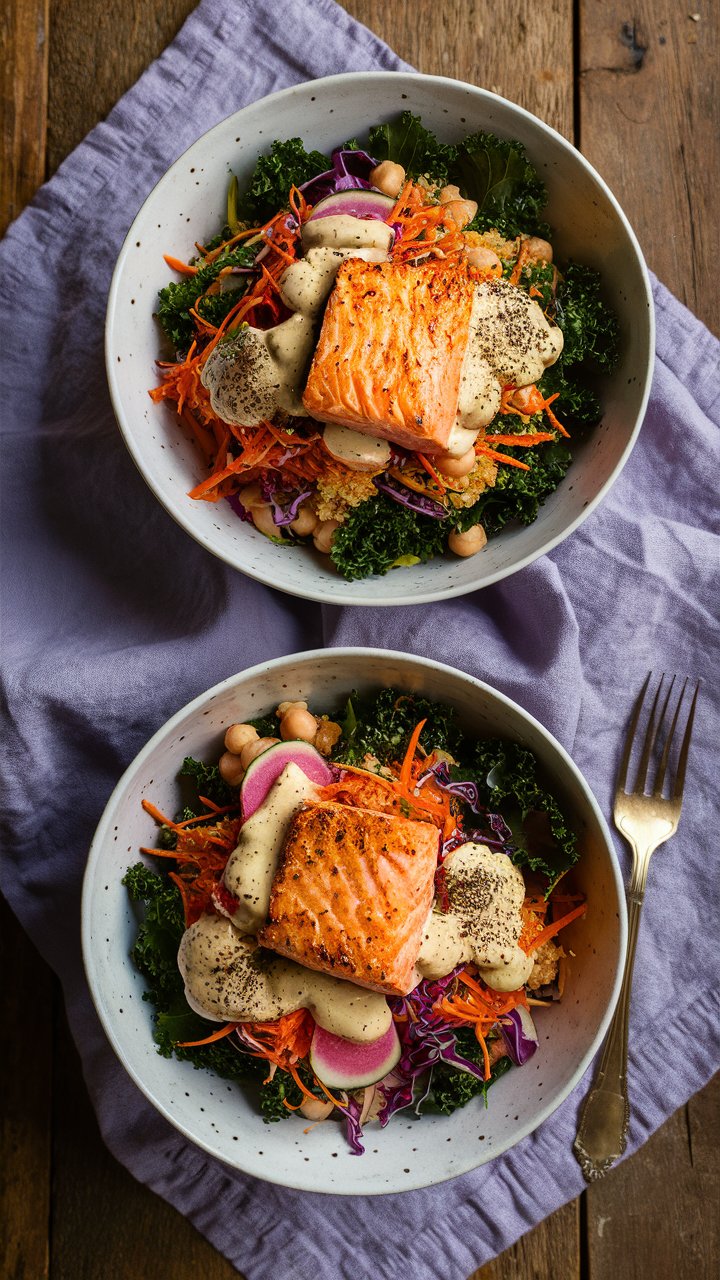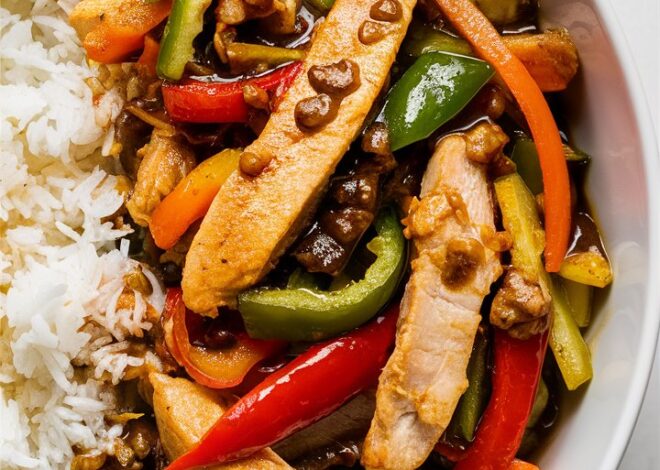
How to Make the Perfect Salmon Buddha Bowl at Home 2025
Buddha bowls have taken the culinary world by storm, offering a vibrant mix of colorful vegetables, wholesome grains, and protein-rich ingredients—all in a single, visually stunning bowl. Among the many variations, the Salmon Buddha Bowl stands out for its perfect balance of flavor, nutrition, and convenience. This recipe combines tender, omega-3-rich salmon with crisp roasted broccoli, protein-packed edamame, fresh vegetables, and a tangy homemade teriyaki sauce. It’s ideal for lunch, dinner, or meal prep, making it a versatile addition to your weekly menu.
In this complete guide, you’ll find step-by-step instructions, expert tips, variations, nutritional insights, and serving suggestions to elevate your Salmon Buddha Bowl experience.
Why You’ll Love This Salmon Buddha Bowl
- Balanced Nutrition – Salmon provides omega-3 fatty acids and high-quality protein, while vegetables add fiber, vitamins, and minerals. Whole grains like brown rice or quinoa complete the bowl, creating a well-rounded meal.
- Flavorful Sauce – The homemade teriyaki sauce is a perfect blend of soy sauce, ginger, garlic, and a hint of citrus from orange juice. It’s glossy, slightly sweet, and incredibly aromatic.
- Easy Prep – Sheet-pan roasting and simple sauce whisking make this recipe approachable even for beginners.
- Customizable – Swap grains or vegetables based on your preference. Want a vegetarian option? Tofu works beautifully in place of salmon.
- Meal-Prep Friendly – Assemble multiple bowls in advance for a week’s worth of nutritious lunches or dinners.
Ingredient Highlights
Here’s what you’ll need for a single batch (adjust quantities for more servings):
- Salmon fillets – Rich in omega-3 fatty acids and protein. Opt for skin-on for extra flavor.
- Broccoli florets – Roasted until slightly charred for a nutty flavor.
- Edamame – Adds a pop of color and boosts protein content.
- Brown rice or quinoa – Provides a hearty, wholesome base.
- Carrot & cabbage – Fresh, crunchy, and colorful vegetables for texture.
- Teriyaki sauce – Homemade with soy sauce, orange juice, rice vinegar, honey, sesame oil, ginger, garlic, and arrowroot starch for thickening.
- Optional garnishes – Sesame seeds, sliced green onions, or pickled ginger.
Expert Tips Before You Start
- Pat salmon dry – This ensures a crisp sear and even roasting.
- Roast broccoli in a single layer – Overcrowding traps steam, making it soggy.
- Whisk sauce constantly – Prevents lumps when thickening with arrowroot.
- Warm grains and edamame – Ensures a pleasant texture in the final bowl.
- Use fresh ingredients – Vibrant vegetables not only taste better but also improve presentation.
Step-by-Step Instructions
Step 1: Roast the Broccoli
- Preheat your oven to 450°F (230°C).
- Toss broccoli florets with 1–2 tablespoons of olive oil, salt, and pepper.
- Spread in a single layer on a sheet pan.
- Roast for 15–20 minutes until tender and lightly golden.
- Optional: Sprinkle a pinch of red pepper flakes for subtle heat.
Step 2: Prepare the Salmon
- Pat salmon fillets dry with paper towels.
- Season with salt and pepper on both sides.
- Set aside while you make the teriyaki sauce.
Step 3: Make the Teriyaki Sauce
- In a small bowl, whisk 1 teaspoon arrowroot starch with 2 tablespoons cold water.
- In a saucepan, combine:
- ¼ cup soy sauce
- ¼ cup fresh orange juice
- 1 tablespoon rice vinegar
- 1 tablespoon honey
- 1 teaspoon sesame oil
- 1 teaspoon grated ginger
- 1 clove garlic, minced
- Bring to a boil over medium heat, then reduce heat to low.
- Whisk in the arrowroot mixture and simmer 3–4 minutes until sauce thickens.
- Adjust sweetness or acidity to taste.
Step 4: Roast the Salmon
- Push the broccoli aside on the sheet pan.
- Place salmon skin-side down and brush generously with teriyaki sauce.
- Roast for 8–12 minutes, depending on thickness, until salmon flakes easily with a fork.
Pro Tip: Salmon continues to cook slightly after removing from the oven, so avoid overcooking.
Step 5: Warm Grains and Edamame
- Cook brown rice or quinoa per package instructions.
- Heat edamame (shelled) according to package directions.
- Keep warm until ready to assemble.
Step 6: Assemble Your Buddha Bowl
- Divide grains evenly into bowls.
- Arrange roasted broccoli, salmon, grated carrot, shredded cabbage, and edamame on top.
- Drizzle remaining teriyaki sauce over the bowl.
- Garnish with sesame seeds and sliced green onions.
Presentation Tip: Arrange ingredients in a rainbow pattern for visual appeal.
Serving Suggestions
- Crisp cucumber salad with rice vinegar dressing complements the richness of salmon.
- Seaweed salad adds umami depth and texture.
- Pickled ginger offers a bright, tangy contrast.
- Pair with miso soup for a complete Asian-inspired meal.
Variations and Substitutions
- Protein swaps: Tofu, chicken, or shrimp work perfectly.
- Grain alternatives: Quinoa, farro, or cauliflower rice.
- Extra vegetables: Roasted sweet potatoes, bell peppers, or snap peas.
- Spicy version: Add chili flakes, sriracha, or a drizzle of spicy mayo.
- Sauce variations: Substitute orange juice with pineapple juice or add a splash of mirin for extra depth.
Nutritional Insights
A single Salmon Buddha Bowl provides a balanced mix of macronutrients:
| Component | Approximate Nutritional Value per Serving |
|---|---|
| Salmon (4 oz) | 230 kcal, 23g protein, 14g fat (mostly omega-3) |
| Brown Rice (1 cup) | 215 kcal, 5g protein, 45g carbs, 4g fiber |
| Broccoli (1 cup) | 55 kcal, 4g protein, 11g carbs, 5g fiber |
| Edamame (½ cup) | 120 kcal, 11g protein, 5g carbs, 4g fiber |
| Teriyaki Sauce (2 tbsp) | 50 kcal, 1g protein, 12g carbs |
| Total | ~670 kcal, 44g protein, 36g carbs, 13g fiber, 14g fat |
Note: Exact values may vary depending on portion sizes and ingredient brands.
Meal Prep Tips
- Prep components separately – Keep grains, vegetables, and salmon in individual airtight containers.
- Assemble when ready to eat – Preserves texture and prevents sogginess.
- Store sauce separately – Maintain flavor by adding teriyaki sauce just before serving.
- Freezing option – Salmon and grains can be frozen; vegetables are best roasted fresh.
Common FAQs
Q: Can I use frozen salmon?
A: Yes, but thaw fully and pat dry before roasting for even cooking.
Q: How do I prevent soggy broccoli?
A: Spread florets in a single layer and avoid overcrowding the pan.
Q: Is arrowroot necessary?
A: It gives a glossy, smooth sauce. Cornstarch works as a substitute.
Q: Can I prep this ahead?
A: Absolutely. Cook all components, store separately, and assemble when ready.
Q: What if I don’t have orange juice?
A: Use pineapple juice or additional rice vinegar for acidity.
Q: How spicy is the sauce?
A: Mild; add chili flakes or sriracha for heat if desired.
Tips for the Perfect Buddha Bowl Experience
- Balance flavors and textures – Mix roasted, raw, crunchy, and soft ingredients.
- Play with color – Bright vegetables make the bowl visually appealing and nutrient-rich.
- Garnish creatively – Sprinkle sesame seeds, sliced green onions, or microgreens.
- Experiment with grains – Mixing brown rice with quinoa adds extra protein and texture.
- Keep it fresh – Use fresh herbs like cilantro or parsley for a pop of flavor.
Why Salmon Buddha Bowls Are a Game-Changer
- Quick yet wholesome – Minimal prep, maximum nutrients.
- Customizable – Works for vegan, pescatarian, or omnivore diets.
- Meal-prep friendly – Perfect for busy weeks.
- Instagram-worthy – Colorful, vibrant bowls look amazing and taste even better.
Whether you’re a busy professional, health-conscious eater, or just love vibrant meals, this Salmon Buddha Bowl fits perfectly into your lifestyle.
Final Thoughts
This Salmon Buddha Bowl is more than just a meal—it’s a nutritious, flavorful, and visually stunning experience. With tender salmon, crisp roasted vegetables, wholesome grains, and a tangy homemade teriyaki sauce, it satisfies both your taste buds and health goals. Easy to prepare, fully customizable, and perfect for meal prep, it’s destined to become a staple in your weekly meal rotation.
Start with the recipe above, experiment with your favorite vegetables, proteins, and sauces, and discover how simple it is to create a restaurant-quality, homemade Buddha bowl.
Embrace the balance of nutrition, flavor, and color—your body and palate will thank you.


